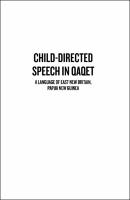Child-directed Speech in Qaqet
A Language of East New Britain, Papua New Guinea
Abstract
Qaqet is a non-Austronesian language, spoken by about 15,000 people in East New Britain, Papua New Guinea. In the remote inland, children acquire Qaqet as their first language. Much of what we know about child‑directed speech (CDS) stems from children living in middle‑class, urban, industrialised contexts. This book combines evidence from different methods, showing that the features typical for speech to children in such contexts are also found in Qaqet CDS. Preliminary insights from naturalistic audio recordings suggest that Qaqet children are infrequently addressed directly. In interviews, Qaqet caregivers express the view that children 'pick up' the language on their own. Still, they have clear ideas about how to talk to children in a way that makes it easier for them to understand what is said. In order to compare adult- and child-directed speech in Qaqet, 20 retellings of a film have been analysed, half of them told to adults and half to children. The data show that talk directed to children differs from talk directed to adults for several features, among them utterance type, mean length of utterance, amount of hesitations and intonation. Despite this clear tendency, there seems to be a cut-off point of around 40 months of age for several of those features from which the talk directed to children becomes more like the talk directed to adults.
Keywords
Qaqet; language; East New Britain; Papua New Guinea; child‑directed speechDOI
10.22459/CDSQ.2022ISBN
9781760465179, 9781760465162, 9781760465179Publisher
ANU PressPublisher website
https://press.anu.edu.au/Publication date and place
Canberra, 2022Imprint
ANU PressSeries
Asia-Pacific Linguistics,Classification
Linguistics
Historical and comparative linguistics


 Download
Download